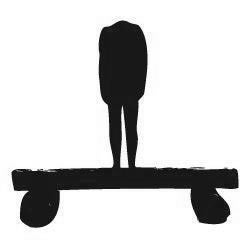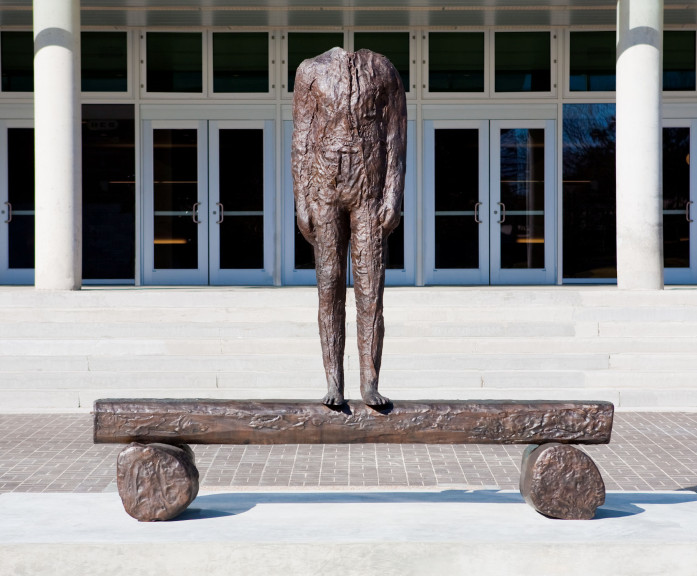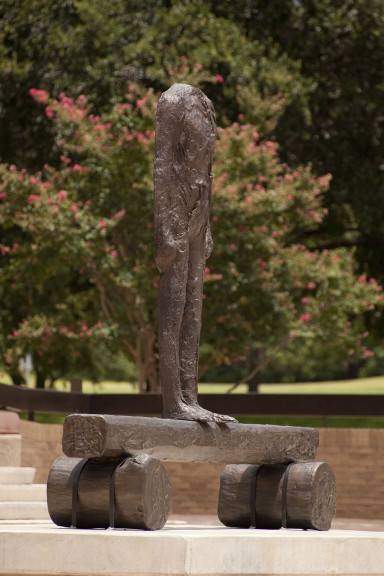Figure on a Trunk
Magdalena Abakanowicz
96 × 103 × 24 inches
Photography not permitted
Lent by the Metropolitan Museum of Art; Joseph H. Hazen Foundation Purchase Fund 2000
2000.348a, b
GPS: 30.2868779, -97.7304335
Profoundly affected by both her solitary childhood and the devastation of World War II, Magdalena Abakanowicz learned to escape loneliness and cruelty by taking refuge in her imagination. When she studied at the Academy of Fine Arts in Warsaw, Poland, in the 1950s, the state-sanctioned artistic style was Socialist Realism. Abakanowicz’s decision to paint plants and natural forms amounted to a radical protest, as cultural production was strictly controlled under the country’s Communist regime.
In the 1960s, she began working with natural fibers, creating weavings of flax, hemp, horsehair, sisal, and wool. Unlike many women weavers of the time, Abakanowicz rejected utilitarian concerns to create large reliefs and freestanding figures she called Abakans: bulbous, flowing, and organic forms suspended from walls or ceilings. These works, with their densely textured surfaces, have a haunting and ominous presence.
As other Polish artists turned from Socialist Realism to abstraction, Abakanowicz became interested in the evocative power of human imagery. Her Garments series, for example, suggests standing figures by means of empty clothing. From the 1970s through the 1990s, she glued burlap sacking and other rough fabrics over metal frames and plaster casts of nude bodies to create figural sculptures that are meditations on aspects of collective life and conformity.
As demand for her work increased, Abakanowicz began casting her burlap pieces in bronze editions. Historical context and sculptural form intersect throughout these works, which consist of identical figures. Ranging in groups from four to more than ninety, repetition evokes the dehumanization of totalitarian societies. Whether alone or multiplied in crowds, the larger-than-life figures are stripped of individual features.
Figure on a Trunk offers a solitary human form, headless and hollow—completely anonymous. Nevertheless, this depersonalized identity belies the handmade texture of the sculpture, which shows the workings of the artist’s hand throughout. A powerful expression of the human condition, Abakanowicz’s sculpture is at once personal and universal — an effigy waiting passively for change and completion.
ACTIVITY GUIDES

Figure on a Trunk
Magdalena Abakanowicz
Subject: Balance
Activity: Create a form that experiments with balance
Materials: Assorted found objects
Vocabulary: Artist, sculpture, figure, balance, stability
Balance is a word we use when we want to say that something is even and stable. If a cup of water is not balanced on a table, it will fall over and the water will spill. A balanced cup will stay upright and won’t fall down. You can walk in a straight line if you have good balance. If you don’t have good balance (meaning you are not even and stable), then you will not walk in a straight line.
We can see balance in the sculptures that artists make. This artist made a sculpture that balances a figure on a shelf. The shelf is also balanced on two logs.
What is unusual about the figure in this sculpture?
Does the figure look stable?
Which piece looks the heaviest?
Which piece looks the lightest?
Would it be easy or hard to balance on two logs?
What would happen if the logs rolled away?
Note the distinction between physical balance and visual balance. Point out both qualities in this sculpture.
Have the child find objects with different shapes, sizes, and weights. Ask him or her to try balancing them in different ways. Note that it is hard to balance things on round objects and it is easier if the lower objects are flat. It is also easier if lower objects are larger and heavier than the objects on top of them. When the child successfully balances objects, look at the form and ask if it is visually balanced as well.
Artist - someone who makes things, such as paintings and sculptures
Balance - to keep steady
Figure - a human shape
Sculpture - a work of art that has height, width, and depth
Stability - being firmly established, fixed, and not moving

Figure on a Trunk
Magdalena Abakanowicz
Subject: Stage
Activity: Put on a performance without using any words or sounds
Materials: None
Vocabulary: Figure, stage, symbolism, performance
Magdalena Abakanowicz is from Poland. She was raised and lived there throughout World War II. This piece is a bronze casting of a headless figure. Abakanowicz makes many sculptures like this one. Sometimes there is just one figure, and sometimes there are many figures in a large group. This figure is standing before us on a platform that is like a stage. When someone is on a stage, they are usually there to tell the audience something, either through speaking or through their performance.
The figure stands on a stage of sorts. What might it be telling us?
Why do you think the artist chose to make this figure without a head?
Can you think of some things that the head and face are symbolic of?
Designate an area that will be your stage. Put on a show for a friend or family. Try to act out feelings and experiences using only your body, but not your voice. Most movies and performances we see incorporate a lot of sound and music to set the mood. How can you set the mood and communicate a message without relying on sound? Can you use all the areas of your stage?
Figure —A human shape
Stage —A platform used for performances
Symbolism —Representing an idea or concept through images
Performance —The act of presenting something (like a play or music) to an audience for entertainment

Figure on a Trunk
Magdalena Abakanowicz
Subject: Voice and identity
Activity: Create an autobiographical drawing
Materials: Pen or pencil and paper
Vocabulary: Identity, figure, symbolism
Magdalena Abakanowicz is from Poland. She was raised there during the violent and oppressive period of World War II. Many of her works deal with issues surrounding repression and individuality. This sculpture is a bronze casting of a headless figure. Abakanowicz makes many works like this one, which are displayed alone or in large groups. These works are often missing parts of their bodies. Sometimes the figures are headless, and sometimes they may be missing their hands or feet. Abakanowicz uses the removal of body parts to symbolize what the figures may be thinking or feeling. When the artist removes certain body parts she limits the figure’s ability to do certain things, like think, speak, walk or feel.
Why do you think the artist chose to make this figure without a head?
What information about the figure do we lose as a result of the missing head?
What events might the artist, who lived under an oppressive regime in Poland, experienced during WWII?
Being headless, the figure cannot talk or think. What are the implications of not having a voice?
Using pen or pencil on paper, make a symbolic timeline of your life. Make a list of the most important things about you, such as life events and your interests. Think about what you would tell someone if you were being introduced for the first time. See if you can develop symbols for each of these items. How can you represent events and ideas visually, without words or numbers? Arrange them so that they effectively tell a story about you without using words.
Identity -- the distinct characteristics and personality of an individual
Figure -- a human shape
Symbolism -- representing an idea or concept through images
MORE INFORMATION
Born to a family of landed gentry, Magdalena Abakanowicz was profoundly affected both by her solitary childhood and by the devastation of World War II. She learned to escape from loneliness and cruelty by taking refuge in imagination, but her imaginings inevitably reflected her world. She studied at the Academy of Fine Arts in Warsaw, Poland, from 1950 to 1954, when socialist realism was the official mode, yet she preferred to paint huge gouaches of abstract plants and natural forms.
Encouraged by the master weaver Maria Laszkiewicz, Abakanowicz soon began working with natural fibers. In the 1960s, she created weavings of flax, hemp, horsehair, sisal, and wool. Her use of natural materials and organic forms was an expression of her resistance to the totalitarian regime and the strictures of socialist realism. Unlike many women weavers of that time and place, Abakanowicz rejected utilitarian concerns to create large reliefs and freestanding forms called Abakans: bulbous, flowing, organic, abstract forms hanging from a wall or ceiling. These works, with their densely textured surfaces that do not invite touch, are haunting and ominous rather than domestic.
After the popular revolution sparked by the labor-union movement Solidarity, socialist realism was no longer the dominant mode of expression. As other artists in Poland turned to abstraction, Abakanowicz became interested in the evocative power of human imagery, but implicit rather than explicit, as in her series of Garments that suggest standing figures by means of their empty clothes.
Although she worked for many years outside the official art system in Poland, Abakanowicz attained international renown. Her fiber works were exhibited widely in museums throughout Europe during the 1970s. The retrospective organized by the Museum of Contemporary Art, Los Angeles, in 1982 brought her critical acclaim in the United States. Since then, her works have been exhibited and acquired by many museums and collectors around the world.
Figure on a Trunk, 2000
From the 1970s through the 1990s, Abakanowicz created many series of figure sculptures, all meditating on aspects of collective life and conformity. Starting with Alterations, she glued burlap sacking and other rough fabrics over metal frames and plaster casts of nude bodies. As demand for her sculptures increased, Abakanowicz had her burlap figures cast into bronze editions.
In some figures, the artist eliminated heads and necks; in others, the hands or feet and even the entire front or rear of the body, as in the monumental Backs of 1976–82. The largest works consist of regimented figures, from as few as four to more than ninety identical figures. Their repetition in rows evokes the dehumanization and anonymity of totalitarian societies.
In contrast, Figure on a Trunk features a lone human form, presented on a stage of sorts, as if for our approval, judgment, or condemnation. The anonymous personage appears to be a dried-up, hollowed-out husk—a mere shell or remnant of flesh, emptied of life and energy. Headless, the figure evokes an effigy, passively waiting for change and completion. The bench on which he stands seems stable, yet it rests on two logs that could roll out from underneath, suggesting a precarious balance.
Valerie Fletcher is Senior Curator at the Hirshhorn Museum in Washington, DC. Her research on groundbreaking aspects of international, globalized, and transnational art have resulted in numerous exhibitions and publications.
Abakanowicz, Magdalena. “Confession: Excerpts from My Autobiography.” Sculpture 24 (October 2005): 30–37.
Abakanowicz, Magdalena, Mary Jane Jacob, and Jasia Reichardt. Magdalena Abakanowicz: Museum of Contemporary Art, Chicago. New York: Abbeville Press,1982.
Bumpus, Judith. “Rope Environments.” [interview] Art and Artists 9 (October 1974): 36–41.
Inglot, Joanna. The Figurative Sculpture of Magdalena Abakanowicz: Bodies, Environments, and Myths. Berkeley: University of California Press, 2004.
Rose, Barbara. Magdalena Abakanowicz. New York: Abrams, 1994.
Wroblewska, Danuta. “Magadalena Abakanowicz.” Craft Horizons 30 (October 1970): 18–23.
The Metropolitan Museum of Art in New York generously loaned twenty-eight modern and contemporary sculptures to Landmarks for display throughout the Austin campus. The collection represents a broad array of artists working in the second half of the twentieth century. The initial sculptures were installed throughout the main campus in September 2008, and a second, smaller group were unveiled at the renovated Bass Concert Hall in January 2009.
Funding for the loan was provided by the Office of the President. This project was the result of a collaborative effort among many, including:
Leadership
Andrée Bober and Landmarks
Pat Clubb and University Operations
Douglas Dempster and the College of Fine Arts
Landmarks Advisory Committee
William Powers and the Office of the President
David Rea and the Office of Campus Planning
Bill Throop and Project Management and Construction Services
Gary Tinterow and the Metropolitan Museum of Art
Samuel Wilson and the Faculty Building Advisory Committee
Project Team
Chuck Agro, transportation, Metropolitan Museum of Art
Andrée Bober, curator and director, Landmarks
Caitlin Corrigan, registrar, Metropolitan Museum of Art
Cynthia Iavarone, collections manager, Metropolitan Museum of Art
Cliff Koeninger, architect
Ricardo Puemape, Project Management and Construction Services
Kendra Roth, conservator, Metropolitan Museum of Art
Patrick Sheehy, installation services
Nicole Vlado, project manager, Landmarks
Special Thanks
Valerie Fletcher, curatorial contributor
Beth Palazzolo, administrative coordination, University Operations
Russell Pinkston, composer
What’s Past Is Prologue: Inaugurating Landmarks with the Metropolitan Sculptures
With the arrival of twenty-eight modern sculptures on long-term loan from New York’s Metropolitan Museum of Art, the Landmarks program has begun. Their installation throughout the Austin campus offers a remarkable opportunity to survey some of the major trends in art during the second half of the twentieth century. These sculptures allow us to witness the distinctly modern dialogue between representation and abstraction, as well as the contest between natural and industrial materials. Most of all, we can celebrate their presence as an unprecedented chance to experience works of art first-hand––to appreciate their forms and to understand the underlying ideas.
The Landmarks program perpetuates in Austin one of civilization’s oldest and most enduring traditions: the placing of art in public areas, accessible to nearly everyone and expressive of collectively held ideas. More than five thousand years ago, the cultures of Egypt and Mesopotamia produced sculptures for urban plazas, government buildings, and places of worship to express political, secular, and religious values. Grand monuments endorsed the ruling elite and commemorated military victories, while images of deities symbolized spiritual beliefs. The original purposes of public art were primarily ideological and didactic, but what has endured through the ages is the physical beauty of the art. In modern times the contexts and goals for public art have changed considerably. In many parts of the world democracy and egalitarianism have supplanted absolute rulers, and explicit religious power has yielded to secular humanism. During the mid-to-late twentieth century (the era when the Metropolitan’s sculptures were created), globalization has redefined the entire world. Societies in Europe and the Americas have became so diverse that cultural authorities can no longer be sure of which systems of meaning and which values, let alone which individuals, should be honored in the traditional ways of public art.
A schism has developed between traditionalists and modernists. In a rapidly changing world those who wanted to preserve the familiar in art have continued to commission representational statues. Modernists, on the other hand, have embraced change and gladly jettisoned the old ways in favor of abstraction. The schism is exemplified by two famous memorials in Washington, D.C., both intended to commemorate the heroic sacrifices of American armed forces. The Marine Corps Memorial (1954) consists of a superbly realistic representation of soldiers struggling to raise the American flag on Iwo Jima in 1945. In contrast, the Vietnam Memorial (1982) consists of a massive V-shaped wedge of polished black stone inscribed with What’s Past Is Prologue: Inaugurating Landmarks with the Metropolitan Sculptures July 2008 the names of the dead. At the time it was inaugurated, this monument shocked nearly everyone outside the art world and outraged many of those it intended to commemorate. In response, a group of bronze figures of soldiers was added. But soon, precisely because of its universal form and absence of imagery, the original memorial became a powerful place where all Americans could go to grieve, remember, and pay homage. To most of the art world, this demonstrated beyond a doubt the viability of abstract sculpture for public places.
With America’s increasing wealth and social consciousness in the 1960s many towns began to institute programs of commissioning sculptures for public places. By requiring that 1 or 2 percent of each building’s construction budget be used for art, urban planners sought to improve the living and working environment for millions of people. The main difficulty was agreeing on what kind of art was visually pleasing and, just as important, potentially meaningful to the general public. Two highly publicized examples were the huge, abstract, metal sculptures by Pablo Picasso and Alexander Calder, in Chicago and Grand Rapids respectively, which at first provoked derision but gradually became a source of community identity and pride.
One way to approach works of art is to consider the historical context in which they were created. During the first half of the twentieth century, life and art underwent radical transformations. Industrial manufacturing supplanted agriculture as the dominant mode of production, people migrated from rural areas to urban centers, women and minorities gained equal rights, warfare expanded to an unprecedented global scale, and technology accelerated the pace of life—and art changed in tandem.
Abstraction
Early in the modern era, many artists believed that a new visual language was needed to replace the Greco-Roman classical figurative traditions that had persisted through two millennia. Photography had made mimesis (accurate depiction of reality) unnecessary in painting and sculpture for the first time in history. Artists were free to conceive radically new approaches, and so abstraction was born, emerging from 1910 to 1920 in Europe. Initially artists simplified and stylized observed reality into organic and angular forms. That first phase soon evolved into making “pure” abstractions with no recognizable sources. From the outset, abstract art carried implicit meanings recognized by artists and informed viewers but largely lost on the general public.
Early abstractionists intended their art to convey their commitment to an ongoing transformation of society. Like Morse code in telegraphy and other new modes of communication fundamentally different from the traditional written word, abstract forms in art could convey meanings—not narrative or literal ones but broad ideas that could speak to an international audience and help advance human consciousness.
During the 1920s and 1930s, artists developed two broad types of abstraction: geometric and biomorphic. Geometry denotes mathematics and suggests such related disciplines as architecture, design, engineering, and logic as well as intangible qualities like analytical thinking and precision—desirable attributes for a rational, communal society. Artists devised a new language of geometry in art: horizontal and vertical elements can convey calm, harmony, and stability (see Harmonious Triad by Beverly Pepper), while rising diagonals can suggest energy and optimism (see Column of Peace by Antoine Pevsner and Square Tilt by Joel Perlman).
In contrast to geometric abstraction, a number of artists favored softer forms and curving contours. Inspired by sources in nature, biomorphic abstractions evoke natural phenomena, biological processes, growth, and ambiguity (see Big Indian Mountain by Raoul Hague, Source by Hans Hokanson, and Untitled [Seven Mountains] by Ursula von Rydingsvard). Such works stand in general opposition to the industrial and technological aspects of modern life; they remind us of the fundamental importance of the natural world. Biomorphism was invented and advocated by the surrealists, who believed in the importance of the unconscious mind in creating and understanding modern art. Relying on the Freudian concept of free association, such artists expect viewers to generate their own unique responses to abstract art.
The two types of abstraction began as competing and opposing philosophies, but by the 1950s many artists expertly combined them to suit their expressive needs (see the rhythmic contours of Veduggio Glimpse by Anthony Caro and the disconcerting, hulking forms of Catacombs and Guardian by Seymour Lipton).
By the 1960s, the original philosophical meanings underlying abstraction had mostly faded away, leaving “formalist” aesthetics: the creation and appreciation of pure nonreferential beauty. Formalism dominated much artistic practice from the 1950s through the 1970s, particularly in the United States in the circle around the critic Clement Greenberg. Geometric sculptures became ubiquitous in public places—some complex and sophisticated and some merely competent. A group known as the minimalists advocated an intellectually rigorous, austerely reductivist approach (see Amaryllis by Tony Smith). Other artists went in the opposite direction, toward complexity and a decorative verve (see Kingfish by Peter Reginato). From those extremes emerged the postminimalists, who infused organic vitality into simple, singular forms (see Curve and Shadow No. 2 by Juan Hamilton).
Figuration
Despite the enthusiasm for abstraction in midcentury, a number of artists insisted on maintaining recognizable human content in their works. Abstraction had alienated many viewers who found it remote or incomprehensible. Yet few artists returned to traditional realism, preferring instead to explore new and evocative modes of representation.
The strongest resurgence occurred in the aftermath of World War II. Many artists, especially in Europe, wanted to pay homage to the sufferings experienced by so many people during the war and to their struggles to rebuild their lives and societies amidst the new fears engendered by the nuclear age and the Cold War. This atmosphere of postwar existential anxiety was poignantly expressed in two museum exhibitions in the 1950s: models for a never-realized Monument to the Unknown Political Prisoner at London’s Tate Gallery in 1953 and the avowedly humanist theme of the New Images of Man installation at New York’s Museum of Modern Art in 1959.
Many postwar sculptors expressed their angst by portraying figures or fragments of bodies as falling, broken, injured, or partially robotic (see Augustus by Bernard Meadows and Figure by Eduardo Paolozzi). Some erudite artists reinterpreted classical myths, particularly those in which a hero challenged the gods and were punished: Icarus, Hephaestus, Prometheus, Sisyphus (see works by Koren der Harootian and Frederick Kiesler). Seymour Lipton created a particularly effective amalgam of figure references within abstract forms that harbor dark inner spaces (see Pioneer, Catacombs, and Guardian).
Representational sculpture was submerged by the tidal wave of abstraction in the 1960s and 1970s, but a new generation insisted on a legible humanist content in art, addressing issues of personal identity and isolation in an impersonal world (see Eyes by Louise Bourgeois and Figure on a Trunk by Magdalena Abakanowicz).
Materials and Methods
Modern sculptors also introduced a new language of materials and methods. In the late nineteenth century, sculpture making had entered a new phase of mass production made possible through technology: bronzes could be produced in large editions by skilled technicians from an artist’s original. The Thinker by Auguste Rodin, for example, was made in several editions, ranging from a dozen life-size bronzes to hundreds of smaller casts. This mechanization and concomitant commodification of art prompted a reaction. Appearing simultaneously in several countries, the “direct carve” movement advocated older craft-based methods and sought to enhance the intrinsic characteristics of natural materials: the color and grain of exotic woods or the veining and crystalline structure of unusual stones. By the 1920s, this aesthetic had gained international prominence, and it persists to this day.
The first generation of direct carvers admired prehistoric, African, Oceanic, and indigenous American artifacts. By adapting the hieratic frontality and stylized forms of those sources to the sleekly refined forms of abstraction, modern sculptors could represent simplified figures linked in sophisticated linear rhythms (see works by Koren der Harootian and Anita Weschler). Recent artists of this orientation tend to work on a larger scale and may roughly cut and hew wood to achieve expressionistic textures (see works by Hans Hokanson and Ursula von Rydingsvard).
Carvers remained a relatively small minority in modern sculpture, far outnumbered by “direct metal” sculptors. Their approach emerged in prewar Europe and burgeoned into an international movement in the 1950s and 1960s. Seeking materials and methods appropriate to the modern Machine Age, artists looked to engineering and construction for inspiration. Instead of using chisels to carve wood and stone, constructivists preferred welding torches to cut and join pieces of metal. Their structures ranged from elegant abstractions to assemblages of cast-off objects.
The industrial analogy and model extended to the sculptors’ own studios, which resembled factory spaces with heavy-duty equipment. Some—like Anthony Caro, Willard Boepple, and Robert Murray—found inspiration in working spontaneously and experimentally with sheet metal: cutting, folding, rolling, welding, soldering, and sometimes painting or burnishing it. Other sculptors, notably Tony Smith, were comfortable with sending models to factories for professional fabrication. Both methods were considered appropriate for a modern world that had been so fundamentally reshaped by industrial manufacture.
In contrast, many sculptors preferred to make assemblages from miscellaneous bits and pieces of scrap, sometimes irreverently called “junk sculpture.” Although artists had experimented with this approach as early as the 1910s, it became a widespread tendency only decades later in the 1950s and 1960s, when sculptors made three-dimensional collages from the detritus of industrial manufacture and mass consumption: rusty machinery, old car parts, squished used paint tubes, broken musical instruments, virtually anything. The motivations for using trash range from simple necessity (when an artist has no money to buy new materials) to antimaterialistic social criticism and environmentalism (sculptors started recycling long before the idea occurred to others).
Regardless of the motivations, a found-object sculpture possesses an inherent dual identity: its former reality as a useful thing and its new reality as art. That dualism inevitably poses an intellectual and visual conundrum for us. Do we see Deborah Butterfield’s Vermillion primarily as a lifelike depiction of a horse or as a composition of rusty, crumpled bits of metal thrown out by a wasteful consumerist society? And what are we to understand from Donald Lipski’s seemingly abstract The West, which consists of decontextualized harbor buoys and lots of corroded pennies? The artists offer clues and hope that we will use our own eyes, intellect, intuition, and imagination to make connections and create meanings.
Landmarks: Sculptures for Inquiring Minds
Unlike works in private collections or even museums, public sculptures exist in our daily environment, interact with our activities, and enter our awareness repeatedly and variously. Beyond the pleasure they bring to viewers already acquainted with art, they can stimulate curiosity and spark new perceptions in the minds of passersby who might otherwise not have much aesthetic experience. As the university’s population seeks knowledge in classes, libraries, and laboratories, the Landmark sculptures can offer other kinds of discoveries. Visitors to the Perry Castañeda-Library, the Nano Science Technology Building, the School of Law, and elsewhere on the campus can now see immediately that the visual arts have a prominent place and come away enriched. Very few campuses or cities can boast so many sculptures of such quality that are free and accessible to all. The twenty-eight sculptures from the Metropolitan Museum of Art proclaim the broad purpose of the Landmarks program: to bring an important new dimension to the life of the university, to the everyday experience of its students, faculty and staff, the citizens of Austin and beyond, and to any person who just crosses the campus.
Valerie Fletcher is Senior Curator at the Hirshhorn Museum in Washington, D.C. Her research on groundbreaking aspects of international, globalized, and transnational art have resulted in numerous exhibitions and publications.



